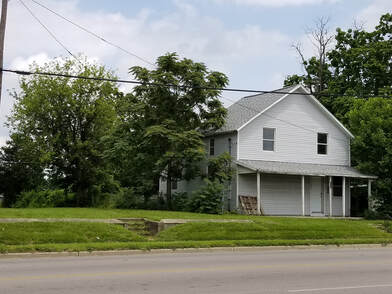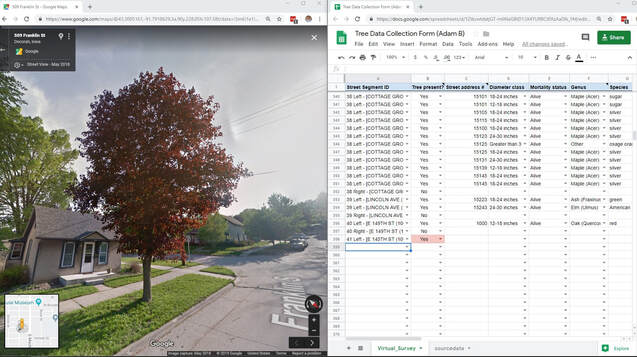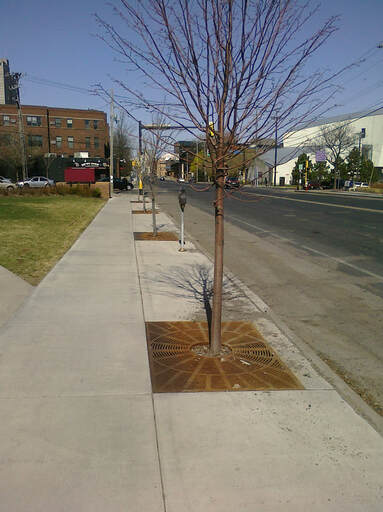Research
My research expertise lies in the areas of urban environmental science, geospatial technologies, and spatial analysis. See a few representative publications featured below.
For more information, see my CV or link to my Google Scholar profile page.
For more information, see my CV or link to my Google Scholar profile page.
Urban greening in shrinking cities
 An abandoned house overgrown by invasive tree-of-heaven. The vacant lot next door is also heavily vegetated. But contrary to prosperous neighborhoods where well maintained vegetation is desirable, the weedy greening on these properties is likely a neighborhood disamenity.
An abandoned house overgrown by invasive tree-of-heaven. The vacant lot next door is also heavily vegetated. But contrary to prosperous neighborhoods where well maintained vegetation is desirable, the weedy greening on these properties is likely a neighborhood disamenity.
Urban greening scholarship has primarily focused on the benefits of greening, and the environmental justice implications of disproportionately lower tree cover in neighborhoods with concentrated minority populations or lower economic prosperity. But in many shrinking cities (i.e., cities experiencing decades-long losses in population and/or economic activity), traditional greening metrics like tree canopy cover that are employed under the assumption that 'greening is good' may be inadequate, because spontaneous weedy vegetation is prominent in neighborhoods with high residential vacancy. Rather than serving as an amenity, this weedy vegetation may actually be characterized as blight that reinforces negative perceptions of high-vacancy neighborhoods. I am using new data sets and approaches to understand the nuances of urban greening in shrinking cities, explain the social and ecological processes behind those patterns of greening, and work toward positive outcomes that benefit the people and the environment in these places.
Selected Publications
Berland A, Locke DH, Herrmann DL, Schwarz K. 2023. Residential land owner type mediates the connections among vacancy, overgrown vegetation, and equity. Urban Forestry & Urban Greening 80: 127826,
doi.org/10.1016/j.ufug.2022.127826.
Berland A, Locke DH, Herrmann DL, Schwarz K. 2020. Beauty or blight? Abundant vegetation in the presence of disinvestment across residential parcels and neighborhoods in Toledo, OH. Frontiers in Ecology and Evolution, https://www.frontiersin.org/articles/10.3389/fevo.2020.566759/abstract.
Schwarz K, Berland A, Herrmann DL. 2018. Green, but not just? Rethinking environmental justice indicators in shrinking cities. Sustainable Cities and Society 41: 816-821, doi: 10.1016/j.scs.2018.06.026.
Herrmann DL, Schwarz K, Shuster WD, Berland A, Chaffin BC, Garmestani AS, Hopton ME. 2016. Ecology for the shrinking city. BioScience 66: 965-973, doi: 10.1093/biosci/biw062.
Selected Publications
Berland A, Locke DH, Herrmann DL, Schwarz K. 2023. Residential land owner type mediates the connections among vacancy, overgrown vegetation, and equity. Urban Forestry & Urban Greening 80: 127826,
doi.org/10.1016/j.ufug.2022.127826.
Berland A, Locke DH, Herrmann DL, Schwarz K. 2020. Beauty or blight? Abundant vegetation in the presence of disinvestment across residential parcels and neighborhoods in Toledo, OH. Frontiers in Ecology and Evolution, https://www.frontiersin.org/articles/10.3389/fevo.2020.566759/abstract.
Schwarz K, Berland A, Herrmann DL. 2018. Green, but not just? Rethinking environmental justice indicators in shrinking cities. Sustainable Cities and Society 41: 816-821, doi: 10.1016/j.scs.2018.06.026.
Herrmann DL, Schwarz K, Shuster WD, Berland A, Chaffin BC, Garmestani AS, Hopton ME. 2016. Ecology for the shrinking city. BioScience 66: 965-973, doi: 10.1093/biosci/biw062.
Street tree inventories using citizen science and street-level imagery
 Using Google Street View to record information about street trees such as location, species, and diameter.
Using Google Street View to record information about street trees such as location, species, and diameter.
Cities are increasingly aware of the value of inventory data for managing municipal street trees, but inventory work is expensive and time-consuming. At the same time, emerging technologies and growing interest in citizen science are creating new possibilities for urban forest monitoring. In this research supported by the TREE Fund, I studied two central questions: (1) What level of data quality can be achieved by analysts manually interpreting street-level imagery to inventory street trees?, and (2) Does data quality vary based on the expertise of the analyst? Our findings indicated that virtual surveys may be a cost-effective approach to generating street tree data, and data quality is good for simple variables like tree location and genus identification (particularly for common trees). Data quality suffers for more detailed variables like species identification and diameter estimation, and experts generally produce more reliable data than novice citizen scientists. Cities can use virtual surveys to generate a simple first-cut inventory of street tree locations, or to update existing inventories.
Selected Publications
Berland A, Roman LA. 2020. New possibilities for virtual street tree inventories. Arborist News 29: 22-26, https://www.fs.usda.gov/treesearch/pubs/59661.
Berland A, Roman LA, Vogt J. 2019. Can field crews telecommute? Varied data quality from citizen science tree inventories conducted using street-level imagery. Forests 10: 349, doi: 10.3390/f10040349.
Berland A, Lange DA. 2017. Google Street View shows promise for virtual street tree surveys. Urban Forestry & Urban Greening 21: 11-15, doi: 10.1016/j.ufug.2016.11.006.
Selected Publications
Berland A, Roman LA. 2020. New possibilities for virtual street tree inventories. Arborist News 29: 22-26, https://www.fs.usda.gov/treesearch/pubs/59661.
Berland A, Roman LA, Vogt J. 2019. Can field crews telecommute? Varied data quality from citizen science tree inventories conducted using street-level imagery. Forests 10: 349, doi: 10.3390/f10040349.
Berland A, Lange DA. 2017. Google Street View shows promise for virtual street tree surveys. Urban Forestry & Urban Greening 21: 11-15, doi: 10.1016/j.ufug.2016.11.006.
Changing urban forest patterns, social-ecological drivers, and environmental justice
 The geographic distribution of urban trees changes over time in response to human and environmental drivers, with implications for quality of life in urban areas.
The geographic distribution of urban trees changes over time in response to human and environmental drivers, with implications for quality of life in urban areas.
As a key component of a city's green infrastructure, urban trees valuable ecosystem services such as stormwater interception, energy savings, and improved public health. I use a variety of techniques including ground-based measurements, geospatial data analysis, and computer modeling to understand how the physical landscape, social characteristics, invasive pests, and management policies combine to influence urban forest change in US metropolitan areas. This research provides local municipalities with practical knowledge to guide urban forest management, and contributes to theoretical understanding of how urban forest dynamics influence the provision of ecosystem services. By studying the relationships between urban tree cover and human population characteristics, I aim for equitable environmental justice outcomes in which urban forest amenities meet the demands of the community fairly with respect to social indicators like income, race, and educational attainment.
Selected Publications
Berland A, Schwarz K, Herrmann DL, Hopton ME. 2015. How environmental justice patterns are shaped by place: terrain and tree canopy in Cincinnati, Ohio, USA. Cities and the Environment (CATE) 8(1): Article 1. URL: https://digitalcommons.lmu.edu/cate/vol8/iss1/1/.
Lockwood B, Berland A. 2019. Socioeconomic factors associated with increasing street tree density and diversity in central Indianapolis. Cities and the Environment (CATE) 12(1): Article 6. URL: https://digitalcommons.lmu.edu/cate/vol12/iss1/6/.
Berland A, Hopton ME. 2014. Comparing street tree assemblages and associated stormwater benefits among communities in metropolitan Cincinnati, Ohio, USA. Urban Forestry & Urban Greening 13: 734-741, doi: 10.1016/j.ufug.2014.06.004.
Selected Publications
Berland A, Schwarz K, Herrmann DL, Hopton ME. 2015. How environmental justice patterns are shaped by place: terrain and tree canopy in Cincinnati, Ohio, USA. Cities and the Environment (CATE) 8(1): Article 1. URL: https://digitalcommons.lmu.edu/cate/vol8/iss1/1/.
Lockwood B, Berland A. 2019. Socioeconomic factors associated with increasing street tree density and diversity in central Indianapolis. Cities and the Environment (CATE) 12(1): Article 6. URL: https://digitalcommons.lmu.edu/cate/vol12/iss1/6/.
Berland A, Hopton ME. 2014. Comparing street tree assemblages and associated stormwater benefits among communities in metropolitan Cincinnati, Ohio, USA. Urban Forestry & Urban Greening 13: 734-741, doi: 10.1016/j.ufug.2014.06.004.
